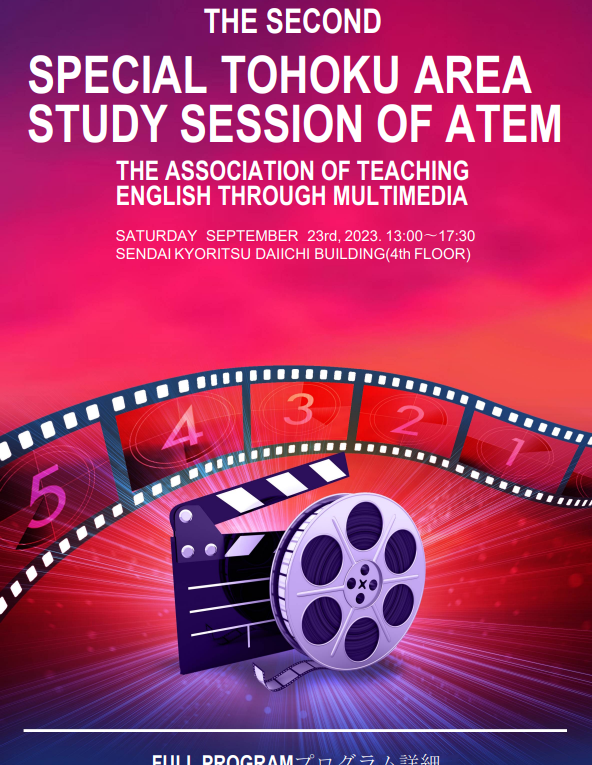2023年12月17日(日)
第14回 ATEM(映像メディア英語教育学会)
東日本支部ハイブリッド支部大会プログラム
14th ATEM Higashi Nihon Chapter Hybrid Conference 12/17/2023
場所:麗澤大学新宿キャンパス 新宿アイランドタワー4階4104号室
Place: Reitaku University Shinjuku Satellite Campus
Shinjuku I-Land Tower 4F Room 4104
オンラインでご参加/ご発表の場合、お名前とご所属(ATEM支部名)をお示しください。会員でない方はお名前とご所属をお示しください。
If you would like to present and/or join the meeting online, please indicate your name and ATEM chapter. If you are not an ATEM member, please indicate your name and affiliation.
Zoomミーティング ID: 835 0882 1568 パスコード: 364839
Zoom ID: 835 0882 1568 Pass code: 364839
参加 Zoom ミーティング
当日何かご連絡が必要な場合はatemhn20@gmail.comにお問い合わせください。
If you need to contact us on the day, please email atemhn20@gmail.com
————————————————————
*12:30 ~ 12:50 Zoomのリハーサル(*希望者のみ)
Zoom Rehearsal for Presenters (Voluntary)
13:00~13:20 開会と支部総会(Opening & General Meeting)
1.13:30~13:50 三村仁彦(帝塚山大学 全学教育開発センター)
動名詞の意味上の主語における所有格・目的格交替について
—映画・ドラマ字幕コーパスからのデータに基づく分析と一指導案—
人称代名詞が動名詞の意味上の主語として生じる場合,本来の形である所有格の代わりに目的格の形をとることがある。
(1) If you don’t mind me asking, when does Your Highness think we’re going home?
『白雪姫と鏡の女王』(Mirror Mirror, 2012) <00:08:37>
この点について,多くの総合英語教材では,Would you mind my[me] …?に代表される人工的な例文と共に「目的格は話し言葉で見られる」といった趣旨の簡単な説明が付されるのみで,その具体的な比率や,典型的な生起パターンなど,その実情が判然としない部分も多い。そこで本発表では,英語会話コーパスの一種である「KUFS映画・ドラマ英語データベース」を利用して,動名詞の意味上の主語における所有格・目的格の交替についてより詳細な分析・記述をおこない,上記の問題をクリアした用例と解説を提示することで,今後の効率的な学習および指導に寄与することを目指す。
≪Q&A: 13:50~13:55≫
2.14:00~14:20 Sachiko NAKAMURA(Tohoku University)
Creation of Video Materials for Learning and Retaining Collocational Knowledge
The importance of learning L2 collocations has been well-documented (e.g., González-Fernández & Schmitt, 2015). Despite the significance, mastering collocations poses a challenge for L2 learners, particularly due to the incongruence between L1 and L2 (e.g., Yamashita & Jiang, 2010). To facilitate L2 English learners to learn and retain collocation knowledge, ultimately making it productive knowledge, the development of effective materials is essential. This presentation explores: 1) why video materials are suitable for learning collocations, 2) considerations for creating the material, and 3) how we can create and share video materials with learners using free websites and applications. The text and audio in the material are provided according to the following procedure (the target collocation in this example is “bear a resemblance”):
1. Full sentence (text – English & Japanese, audio – English): “The ancient artifact bears a resemblance to those found in neighboring regions.”
2. Pause for learner repetition
3. Repetition of 1) & 2)
4. First chunk (text – English & Japanese, audio – English): “The ancient artifact”
5. Pause for learner repetition
6. Second chunk (text – English & Japanese, audio – English): “bears a resemblance”
7. Pause for learner repetition
8. Third chunk (text – English & Japanese, audio – English): “to those found in neighboring regions”
9. Pause for learner repetition
10. First chunk (no text information, audio – English)
11. Pause for learner repetition
12. Second chunk (no text information, audio – English)
13. Pause for learner repetition
14. Third chunk (no text information, audio – English)
15. Pause for learner repetition
16. Full sentence (no text information, audio – English)
17. Pause for learner repetition
18. Repetition of 16) & 17)
The learners’ reactions to the material are also introduced in the presentation.
≪Q&A: 14:20~14:25≫
3.14:30-14:50 Christopher R. Cooper (Rikkyo University)
Supporting an English through movies course with an IMDb review corpus
When teaching a course without a textbook, a corpus can be a useful tool
to provide language support to L2 users. Recently, there are an increasing number
of open-source datasets available, providing access to large bodies of texts from
various registers. In the current study an open-source dataset of 25,000 positive
and 25,000 negative online movie reviews was used to provide language support
to university students on an ‘English through Movies’ elective course. AntConc
was used to extract keywords from the positive reviews, using the negative
reviews as a reference corpus, then the opposite was done for negative reviews.
Only giving students a list of words may not be the ideal kind of support, as no
indication about usage is given. Therefore, the ‘order by frequency’ setting was
used in AntConc’s KWIC tool to find frequently occurring phrases and patterns.
Documents were provided to students based on the corpus analysis to help them
write movie reviews, have discussions and give presentations. In addition, several
activities were constructed using the positive and negative language. In this
presentation the keyword extraction process will be explained, and example
materials and tasks will be shared, along with reflections on their use in the
classroom.
≪Q&A: 14:50~14:55≫
Coffee Break 15:00~15:25
4.15:25~15:45 山本五郎(法政大学)
Well-beingをテーマにした英語総合教材の開発
本発表では、Well-beingをテーマにした英語教材開発の実践報告を行う。ウェルビーイングは昨今様々な文脈で見聞きすることが増えており現代のキーワードの一つである。ウェルビーイングは端的に言えば「健康で幸福な暮らし」を意味するが、社会基盤が整った日本ではどのような要素がウェルビーイングを構成するのか日頃意識して考える機会がない学習者も多い。今回取り上げる教材では、ウェルビーイングについての知識を深めるとともにニュース動画を用いて学習者の問題意識を高めることを目的としている。
本発表では、2024年に出版予定の教材について、ユニットの構成、ユニット内の各セクションの内容と狙い、問題形式、ニュース動画・画像素材の選定、オンライン情報とのリンクなどについて概観し、その企画・開発や活用上の特性に関してMayer and Sims (1994)の評価基準に沿って説明する。
今回報告する教材開発は、折しもChatGPTの普及とその語学学習への活用が取り沙汰された時期に行われた。教材は生成AIの活用を主軸に据えたものではないが、発表ではChatGPTを用いた発展的学習の可能性についても言及する。
≪Q&A: 15:45~15:50≫
5.16:00-16:20 塚田三千代(翻訳/映画アナリスト)
映画『CATS』(2018)の分析と英語教育への運用― Jellicle Cats の合成語
物語は1930年代後半のロンドン・ソーホー地区のゴミ捨て場に、白い子猫が人間に捨てられた場面から始まる。そこは‘ジェリクルキャッツ’族が支配する場所である。ミルクバーの文化がある。手品師の奇跡技…鉄道猫のタップ…グリザベラ猫の徘徊…Heaviside Layer 旅への憧憬… 終盤は英国ロンドンのトラファルガー広場に集まって、白石のオベリスクを遠景にライオン像の傍で、仕事もゲームも楽しむ誇り高き猫たちと 「交際するルール」 を、歌唱して閉じる。発表ではミュージカル映画CATSの概要、‘ジェリクルキャッツ’の多様性、原作:T. S. Eliotの “The Naming of Cats”、‘ジェリクルキャッツ’歌唱コンテスト場面の名曲“Memory”を生成する。文化遺産と伝播、等を説明し、JellicleやHeaviside Layerの合成語やWイメージによる言葉遊びの社会風刺も言及する。
≪Q&A: 16:20~16:25≫
6.16:30~16:50 Yoshikazu NISHI(ATEM Hokkaido)
How to make lesson plans for new exam
The Hokkaido public high school entrance exam has already changed dramatically in 2022. Accordingly, the university entrance exam will change radically once again in 2025.
Because we need creative young people in Japan, the Japanese educational ministry wants to improve school lessons now. Therefore, schools must create new, more active lessons to foster a more adaptable workforce. Previously, the world needed young people who had enough knowledge. However, creative people who can think outside the box and adapt quickly are increasingly required.
As a result, school teachers have to change their lessons to encourage this different way of thinking. However, it is very challenging to change our teaching habits.
In this presentation, I would like to do two things.
First, I will show you a real example from high school entrance exams in Hokkaido from 2023. Then, I will explain what makes this a creative exam.
Second, teachers have to adapt their lesson plans for this new type of exam. Therefore, I will demonstrate some ways to encourage student adaptability with examples.
≪Q&A: 16:50~16:55≫
7. 17:00-17:20 高橋亮太(兵庫県立大学4年)
シャドーイングと『ボス・ベイビー』(2017)による英語教育の検証実験
本発表は、2023年7月に行った映画『ボス・ベイビー』(2017)を用いたシャドーイングの検証実験についての結果のレビューを行う。2022年12月は『ボス・ベイビー』(2017)について、物語の構造と台詞の観点から分析し、数多くのアカデミアの先生方から英語研究の意義、英語研究の進め方などコメントやご助言をいただき、その中でも「どのようにして教育の場に活かすか」について着目した。兵庫県立大学国際商経学部グローバルビジネスコースの学生計50名を対象に検証を行い、それに対するレビューのアンケート調査を実施し比較を行った。本発表ではそこから得られた結果を分析し、主に①シャドーイングを用いる効果、②アニメーション映画を用いる有効性について述べる。本発表後は、『ボス・ベイビー』(2017)に限らず、他のアニメーション映画(主にドリームワークス・アニメーション)の教材化の可能性についても今後検討していきたい。
≪Q&A: 17:20~17:25≫
17:30~17:35 閉会 (Closing)
